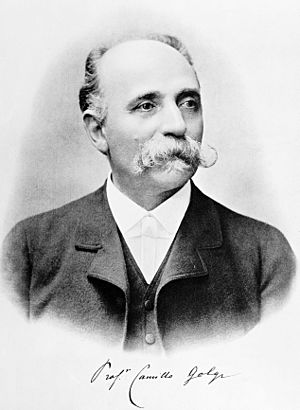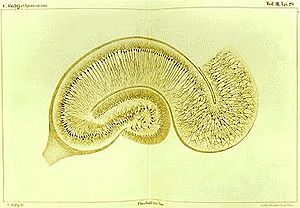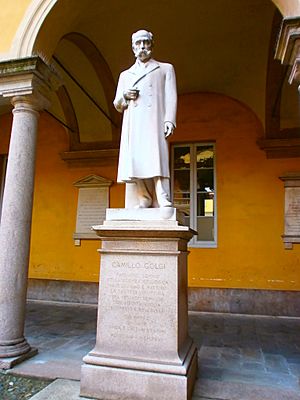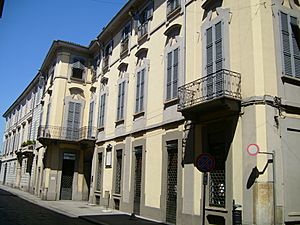Camillo Golgi facts for kids
Quick facts for kids
Camillo Golgi
|
|
|---|---|
 |
|
| Born | 7 July 1843 Corteno, Kingdom of Lombardy–Venetia, Italy
|
| Died | 21 January 1926 (aged 82) |
| Alma mater | University of Pavia |
| Known for | Golgi's method Golgi apparatus Golgi tendon organ Golgi cell Golgi cycles Reticular theory Radial glial cell Perineuronal net |
| Awards | Nobel Prize in Physiology or Medicine (1906) |
| Scientific career | |
| Fields | Pathology Neuroscience |
| Doctoral advisor | Cesare Lombroso |
| Doctoral students | Antonio Pensa |
Camillo Golgi (born July 7, 1843 – died January 21, 1926) was an Italian biologist and pathologist. He is famous for his important work on the central nervous system, which is the brain and spinal cord.
Golgi studied medicine at the University of Pavia from 1860 to 1868. He later spent most of his career there. In 1873, he made a huge discovery: a special staining technique called the "black reaction." This method helped scientists see nerve cells clearly for the first time. Because of his work, many parts of the body and their functions are named after him, like the Golgi apparatus and the Golgi tendon organ.
In 1906, Golgi shared the Nobel Prize in Physiology or Medicine with Spanish biologist Santiago Ramón y Cajal. They received the award for their discoveries about how the nervous system is built.
Contents
Biography of Camillo Golgi
Camillo Golgi was born on July 7, 1843, in a small village called Corteno in Italy. His father, Alessandro Golgi, was a doctor. The village is now named Corteno Golgi to honor him.
In 1860, Camillo started studying medicine at the University of Pavia. He earned his medical degree in 1865. After his studies, he worked as a doctor in the Italian Army and at a hospital in Novara. He also helped investigate cholera outbreaks near Pavia.
In 1867, he continued his studies with Cesare Lombroso, a famous scientist who studied the mind. Golgi became very interested in how the brain works. He then joined the Institute of General Pathology, led by Giulio Bizzozero. Bizzozero was a great teacher who studied the nervous system. Golgi and Bizzozero became very close friends. Golgi later married Bizzozero's niece, Lina Aletti.
Early Discoveries and Return to Pavia
By 1872, Golgi was a skilled doctor and expert in studying tissues. However, he didn't have a chance to teach or do research in brain science at Pavia. Because of money problems, he took a job as Chief Medical Officer at a hospital near Milan in 1872.
To keep doing his research, he set up a small lab in a hospital kitchen. It was there that he made his most important discovery: the "black reaction" staining method. He published his main findings between 1875 and 1885.
In 1875, he joined the faculty of histology (the study of tissues) at the University of Pavia. He became a full professor there in 1880. He also served as the head of the University of Pavia twice, from 1893 to 1896 and again from 1901 to 1909. During World War I, he managed a military hospital. He retired in 1918 but kept doing research until 1923. Camillo Golgi passed away on January 21, 1926.
Personal Life
Camillo Golgi and his wife, Lina Aletti, did not have their own children. They adopted Golgi's niece, Carolina.
Golgi's Scientific Contributions
Camillo Golgi made many important discoveries that changed how we understand the human body.
The Black Reaction: Seeing Nerve Cells Clearly
During Golgi's time, it was very hard to study the Central nervous system because nerve cells were difficult to see. The usual staining techniques didn't work well for brain tissue.
While working at the hospital, Golgi experimented with staining nerve tissue using silver. In 1873, he found a way to stain only a few nerve cells completely, making them stand out. He first treated the tissue with a chemical to harden it, then with silver. Under the microscope, the nerve cells looked very clear and black against a yellow background. This made it possible to see the full shape of nerve cells, including their main body (soma), long fibers (axons), and branching parts (dendrites).
Because the cells turned black, he called his method la reazione nera ("the black reaction"). Today, it's known as Golgi's method or the Golgi stain. He published his discovery on August 2, 1873.
Understanding the Nervous System

Before Golgi, some scientists thought the brain was a continuous network, like a single tangled web. Using his black reaction, Golgi could map different parts of the brain and spinal cord. He could clearly tell the difference between axons and dendrites.
Golgi believed that the brain was a "diffuse nervous network," meaning all nerve fibers were connected in one big web. This idea is called the reticular theory. However, another scientist, Ramón y Cajal, used Golgi's own staining method to show something different. Ramón y Cajal argued that the nervous system is made of individual cells called neurons, which are connected but separate. This idea is called the Neuron doctrine. Even though Golgi and Ramón y Cajal had different ideas, they both won the Nobel Prize for their work on the nervous system.
Golgi was also the first to clearly describe parts of the brain like the cerebellum, hippocampus, and spinal cord. In 1878, he discovered a special organ that senses changes in muscle tension, now called the Golgi tendon organ.
Work on Kidneys
Golgi also studied how kidneys work from 1882 to 1889. He observed how kidneys grow and repair themselves. He was the first to carefully separate the tiny filtering units of the kidney, called nephrons. He showed that a part of the nephron loops back to its starting point.
Research on Malaria
In 1880, a French doctor discovered that malaria was caused by a tiny parasite. Many scientists doubted this until Golgi helped prove it. From 1885, Golgi studied the malaria parasite and how it spreads.
He identified two types of malaria fevers, caused by different parasites. In 1886, he found that the malaria fever (paroxysm) happens when the parasite reproduces in human blood. This is now called the erythrocytic cycle or Golgi cycle. By 1898, Golgi and other scientists confirmed that malaria is spread by Anopheline mosquitoes.
Discovery of the Golgi Apparatus
An important part inside eukaryotic cells is now known as the Golgi apparatus. Camillo Golgi discovered it. He changed his black reaction method to stain nerve cells from an owl's brain. He saw thread-like networks inside the cells and called them internal reticular apparatus.
He shared his discovery in April 1898. However, many scientists thought he was wrong and that what he saw was just a mistake from the staining process. Their microscopes weren't strong enough to see these tiny parts clearly. It wasn't until 50 years later, when electron microscopes were invented, that Golgi's discovery was finally proven true.
Awards and Legacy
Camillo Golgi, along with Santiago Ramón y Cajal, received the Nobel Prize in Physiology or Medicine in 1906 for their studies on the nervous system. In 1900, the King of Italy made him a senator. He also received honorary degrees from several famous universities around the world. In 1994, the European Community honored him with postage stamps.
Monuments in Pavia
In Pavia, Italy, there are several places that remember Camillo Golgi:
- A marble statue of Golgi stands in a courtyard at the University of Pavia. The statue has an inscription that praises him as a great pathologist who discovered the secret structure of nerve tissue.
- "Golgi’s home" is also in Pavia, where he lived most of his family life with his wife, Lina.
- Golgi's tomb is in the Monumental Cemetery of Pavia. It is a simple granite grave with a bronze picture of him.
- A Golgi's museum was opened in 2012 at the University of Pavia. It shows a recreation of his study and laboratories with his original furniture and tools.
Things Named After Golgi
Many things in science are named after Camillo Golgi because of his important discoveries:
- The cell organelle: Golgi apparatus
- The sensory part in muscles: Golgi tendon organ
- The staining technique: Golgi's method
- A type of nerve cell in the brain: Golgi cells
- Two types of nerve cells based on their axons: Golgi I and Golgi II nerve cells
- A crater on the Moon: Golgi (crater)
- A minor planet: 6875 Golgi
See also
 In Spanish: Camillo Golgi para niños
In Spanish: Camillo Golgi para niños
- List of pathologists




